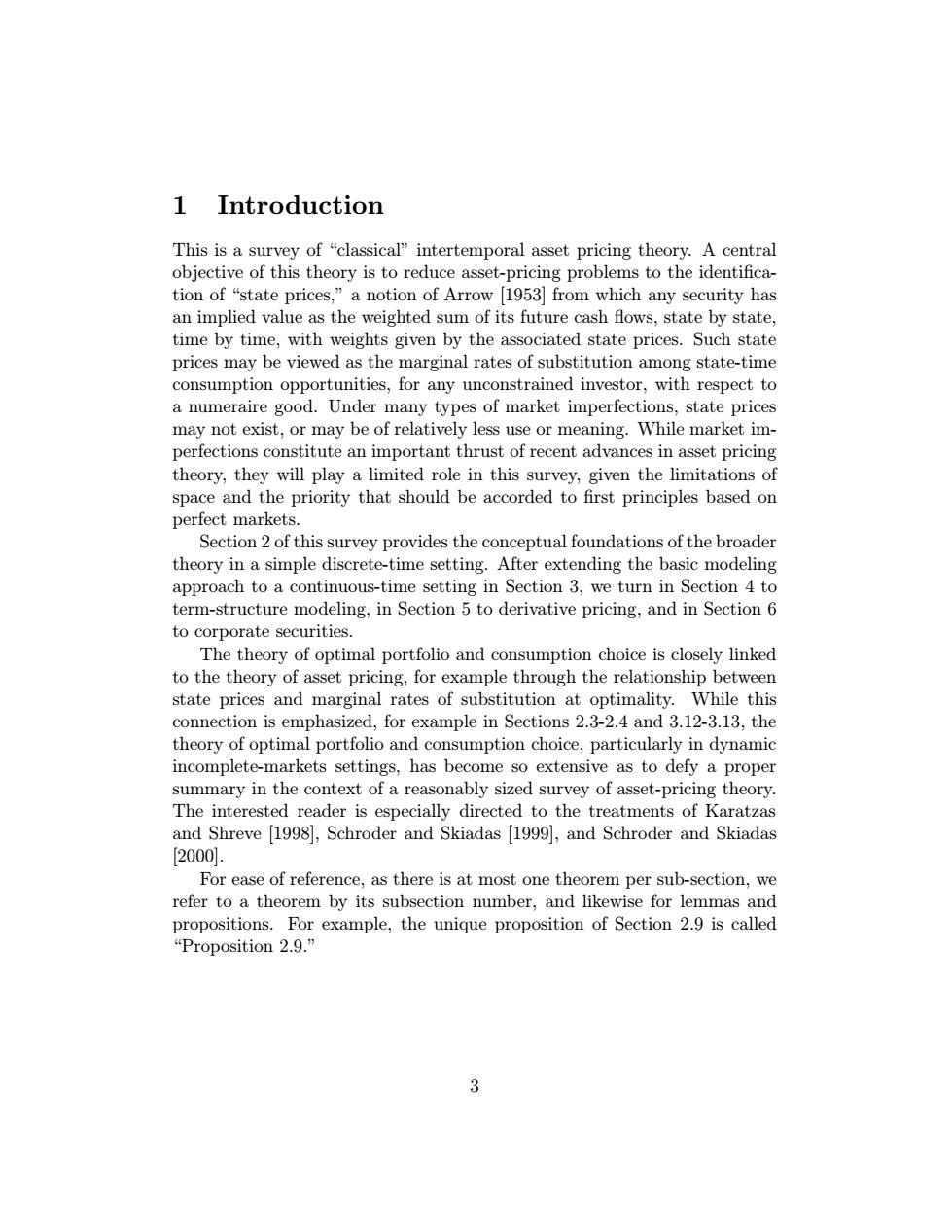正在加载图片...

1 Introduction This is a survey of "classical"intertemporal asset pricing theory.A central objective of this theory is to reduce asset-pricing problems to the identifica- tion of "state prices,"a notion of Arrow [1953 from which any security has an implied value as the weighted sum of its future cash flows,state by state, time by time,with weights given by the associated state prices.Such state prices may be viewed as the marginal rates of substitution among state-time consumption opportunities,for any unconstrained investor,with respect to a numeraire good.Under many types of market imperfections,state prices may not exist,or may be of relatively less use or meaning.While market im- perfections constitute an important thrust of recent advances in asset pricing theory,they will play a limited role in this survey,given the limitations of space and the priority that should be accorded to first principles based on perfect markets. Section 2 of this survey provides the conceptual foundations of the broader theory in a simple discrete-time setting.After extending the basic modeling approach to a continuous-time setting in Section 3,we turn in Section 4 to term-structure modeling,in Section 5 to derivative pricing,and in Section 6 to corporate securities. The theory of optimal portfolio and consumption choice is closely linked to the theory of asset pricing,for example through the relationship between state prices and marginal rates of substitution at optimality.While this connection is emphasized,for example in Sections 2.3-2.4 and 3.12-3.13,the theory of optimal portfolio and consumption choice,particularly in dynamic incomplete-markets settings,has become so extensive as to defy a proper summary in the context of a reasonably sized survey of asset-pricing theory. The interested reader is especially directed to the treatments of Karatzas and Shreve [1998,Schroder and Skiadas [1999],and Schroder and Skiadas [20001. For ease of reference,as there is at most one theorem per sub-section,we refer to a theorem by its subsection number,and likewise for lemmas and propositions.For example,the unique proposition of Section 2.9 is called “Proposition2.9.” 31 Introduction This is a survey of “classical” intertemporal asset pricing theory. A central objective of this theory is to reduce asset-pricing problems to the identification of “state prices,” a notion of Arrow [1953] from which any security has an implied value as the weighted sum of its future cash flows, state by state, time by time, with weights given by the associated state prices. Such state prices may be viewed as the marginal rates of substitution among state-time consumption opportunities, for any unconstrained investor, with respect to a numeraire good. Under many types of market imperfections, state prices may not exist, or may be of relatively less use or meaning. While market imperfections constitute an important thrust of recent advances in asset pricing theory, they will play a limited role in this survey, given the limitations of space and the priority that should be accorded to first principles based on perfect markets. Section 2 of this survey provides the conceptual foundations of the broader theory in a simple discrete-time setting. After extending the basic modeling approach to a continuous-time setting in Section 3, we turn in Section 4 to term-structure modeling, in Section 5 to derivative pricing, and in Section 6 to corporate securities. The theory of optimal portfolio and consumption choice is closely linked to the theory of asset pricing, for example through the relationship between state prices and marginal rates of substitution at optimality. While this connection is emphasized, for example in Sections 2.3-2.4 and 3.12-3.13, the theory of optimal portfolio and consumption choice, particularly in dynamic incomplete-markets settings, has become so extensive as to defy a proper summary in the context of a reasonably sized survey of asset-pricing theory. The interested reader is especially directed to the treatments of Karatzas and Shreve [1998], Schroder and Skiadas [1999], and Schroder and Skiadas [2000]. For ease of reference, as there is at most one theorem per sub-section, we refer to a theorem by its subsection number, and likewise for lemmas and propositions. For example, the unique proposition of Section 2.9 is called “Proposition 2.9.” 3